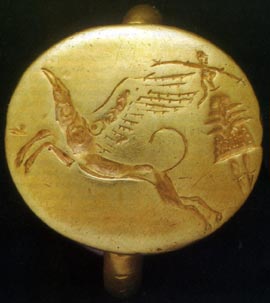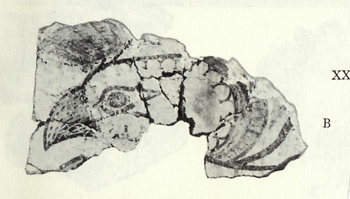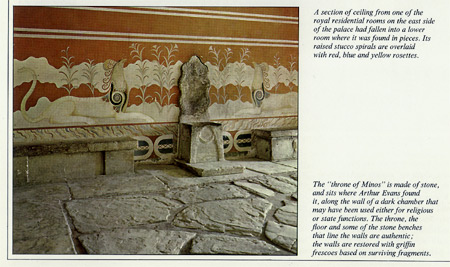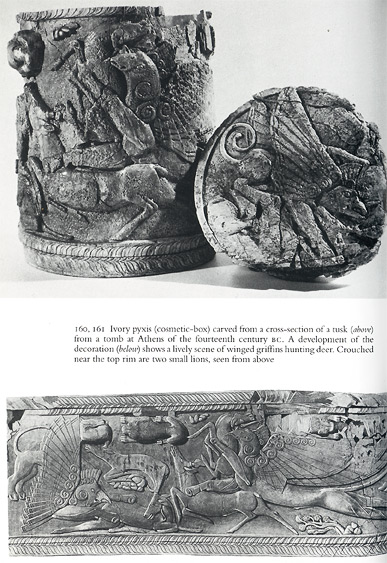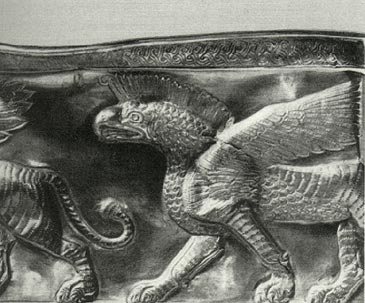The
internet should never be the primary source for
information, and should always be used with extreme
caution. This page has come into existence because
I stumbled upon an internet site dedicated to the
griffin (alernately: "gryphon", "gryps"). On that
site the author stated that the griffin was adopted
by Greeks from the Scythians in the 6th century
BC... and the reasoning proffered as a means of
supporting this hypothesis was that the author
of that page had never encountered the griffin's
role in any Greek myth. This page contains griffins
from the Greek world that are one thousand years
older than the Scythian-adoption claim made on
that site. The earliest depictions of griffins
occur on the Greek island of Thera and date to
the 17th century BC or earlier. These frescoes
were painted some time before the volcano erupted.
The date of the eruption of the volcano at Thera
has now been dated to 1623 BC (refer:
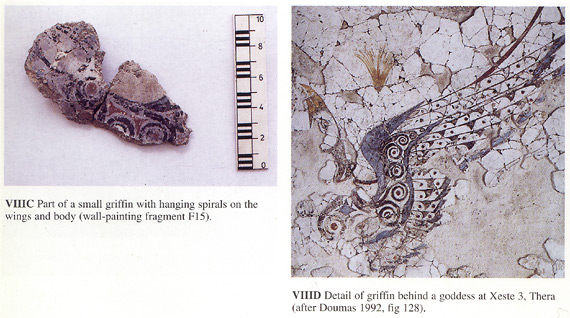 Scans from AVARIS the capital of the Hyksos. Recent excavations at Tell el-Dab'a by Manfred Bietak, published by the British Museum Press. isbn 0 7 141 09681 Above left, portion of wing from fresco fragments, Avaris, Egypt. Above right, griffin on pre-eruption fresco Thera. Bietak's book is the publication of his excavation results at Avaris, Egypt. (Amazon Link) Representations, identical in style to those found on Thera of the griffin - which first appear before the 17th century BC - are those which appear on Minoan signet rings. The example below is a gold ring from Tholos Tomb B at Archanes Krete. It dates to c. 1450-1300 BC (probably earlier). Illus. 68, J & E Sakellarakis, Crete Archanes isbn 9602132345. It shows a griffin accompanying, as in Thera, a goddess.
The griffin accompanying the goddess is a theme which is continued by the Mycenaeans and appears on frescoes found at Mycenae.
Above is a fragment of a wall
painting showing a warrior goddess, probably Athena, in the Cult Centre
of Mycenae (c. 1300 BC?). Illus. 104, Schofield, The Mycenaeans isbn
9780714120904. The griffin faces backward. This style (with backward
facing creatures) was taken to the Levantine coast by the Mycenaean settlers
there, the Philistines. The goddess here is not only accompanied by a
griffin but wears a boar's tusk helmet. These helmets appear on another
fresco from Thera which (dates before the volcanic eruption). It is these
helmets which were worn by the Greeks, and described by Homer, when they
besieged Troy. Below a griffin's head from a Mycenaean period fresco from Pylos
Fragment of a Griffin head from the "Queens Megaron", Pylos (Greece). 15th(?) century BC. The three scans of fresco paintings of griffins are all executed in the same style. The one from Thera dates to before 1623 BC, prior to the eruption of the volcano. The one from Avaris, the capital of Hyksos-ruled Egypt, also dates to c. 1600 BC. The griffin is only introduced into Egypt during the Hyksos period. The style of painting is the same as at Aegean Thera. It continued on the Greek mainland after the eruption of the volcano at Thera, but disappeared from Egypt with the expulsion of the Hyksos.
This
image is scanned from:
Scanned
from Figure 35, p. 165 The Lost World of Elam:
Re-creation of a Vanished Civilization, by
Walther Hinz, published by Sidgwick & Jackson.
isbn 0 283 97863 5 (Amazon
link) This
griffin is the "blue-glazed griffin" recovered in
fragments from the ziggurat at Choga Zanbil (Choga
Zambil). According to Hinz this ziggurat was founded by Untashnapirisha in the mid 13th century BC (pp.166-167) Which means that the griffin had been in existence for approximately 400 years in the Aegean before it arrived in Elamite Susa, and is therefore not "an original Elamite invention" as is claimed by Hinz! Its introduction into Egypt was during the Hyksos period. In the Wikipedia entry on the griffin, the Aegean griffins are entirely omitted, hence creating the impression that the origin of the griffin lies instead in the Near East. What is depicted is a griffiin from Marlik,Iran (pictured below), which dates to between the 12th - 13th centuries BC (c. 1250-1150 BC). The griffins of the Aegean predate the Marlik griffin by 400 years. The Wikipedia page can be found here: http://en.wikipedia.org/wiki/Griffin (Unfortunately I took no screenshot of the Wikipedia page - which had been altered by the time I revisited it.)
The latest incarnation of the Wikipedia page on the griffin endeavours to further misinform anyone who seeks information on the griffin. Below are screenshots of the latest claim (22/7/2008) found there:
The lengths taken to establish and secure a Near Eastern origin of the griffin, despite incontrovertible evidence to the contrary by the Wikipedia, indicates that an agenda other than one intended to inform motivates its editors. What is presented as information on the Wikipedia is, unless corroboration of what is presented on it as "fact" elsewhere, likely to be the fantasy of one of its anonymous editors. What needs to be pointed out is that the creature on the Lagash vase is quadrupedal; it has ventral scales on its underside - these are found only on snakes, not lizards, thus though it is quadrupedal it is not a lizard; it has a snake/lizard head, and not the bird/eagle/vulture beak of a griffin; it has hands with opposable thumbs on its upper limbs and it has bird talons, not the clawed paws of a griffin, for its lower limbs. This is not a griffin! The Lagash vase depicts a quadrupedal taloned and winged horned snake beast. What the guardians on the Lagash vase are intended to depict are the "horned serpent" and/or mushussu-dragon of mesopotamian myth - not a griffin.
|
